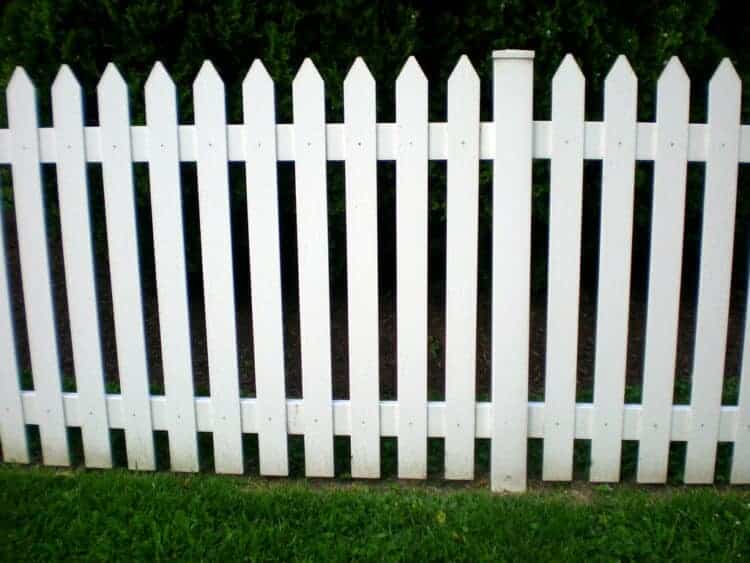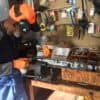
One of the most important and fun DIY projects you could ever do is building a fence. When you are building a fence, you may want to consider curb appeal and durability. That is where a fence rot board comes in.
A fence rot board (also called a kickboard) is usually installed at the bottom of the fence. By including it in a fence, it protects the wood building the fence. It is also for curb appeal. Thus, it acts as a great finish to the fence.
When building a fence, you need to raise it from the ground. That way you protect it from rot and decomposition. This is where kickboards come in. When used together with trim boards and cap boards, they give the best finish to fences.
Different people prefer different sizes for the kickboard. The width and thickness may vary. The size picked depends on the space separating the fence from the ground.
The wood used to make the boards is usually treated. After treatment, it repels water, insects, and other hazards.
You should incorporate a rot board in the building of the traditional picket fences. The best way to understand how to go about fence building projects is by learning from people who did it for themselves.
You also get to see the new ways of building design fences. The main theme of these cool custom fences is the metal used along with other materials like wood and PVC.
The main feature that stands out is the protective metal frame. You use it to encase the materials you want to use for your fencing. It also serves as a kickboard. It adds to the curb allure and preserves the wood if that is the stuff you want to use for your fence.
Also in the article, become aware of different types of wood that repel insects. There is so much for you to learn about building long-lasting, appealing fences. The process of getting the fence and gate up is also manageable and easy to follow.
Table of Contents
How to DIY a custom cedar privacy fence
The couple in the spotlight chose a privacy fence for the privacy of the family as they lived near a busy road. They selected cedar for the project because it is durable and repels pests.
The other reason was that cedar had a beauty to it. The location of the home had many passers-by.
The DIY project was to make sure that the family did not spend much money on the project. That is why they decided to build the fence themselves. The fact is hiring someone to build a fence for you will be expensive.
Some of the tools they used are a finish nailer, table saw, and circular saw. They also used exterior screws, and fence support of steel rails.
Some fence pickets from five by four inches thick were added. Also, six inches wide cedar decking, and two by four cedar rails were in the fencing project.
The cedar pillars were four by four. Then there was the cement mix and a digger for post holes.
There were several steps taken, given in detail, that got the fence up and finished. Following through with the steps they took will help get your privacy fence up.
First, they had to assemble the supplies and source the cedarwood. They wanted to know where to get the wood and materials as the need arose. This was to avoid the expenses of hiring bigger means of transport for the whole load at once.
The fence panels were thick and had round appealing edges. The fence pickets used in the front were longer than the rest. They needed more privacy from the front.
The second step was digging the holes, adding the posts, and sealing them in with cement. They cut boards used in the fitting and nailed them in place.
The connection of the fence had two big posts on the driveway which became the gate posts. With privacy fence panels, you do not have to waste too much time.
You do not have to be exact with the inches like what happens with pre-made panels. It is cheaper and preserves trees.
A little tip to keep in mind is, digging holes in the same radius as the digger preserves the amount of concrete used. The posts used for the privacy fence were longer than usual. The trimming and leveling were after finishing the fencing.
In the third step, they built the panels for the privacy fence. They cut two by four rails that they connected to the upper and lower parts of the fence.
The support connection was the post. The rail is connected to the support using exterior screws.
Afterward, they leveled the rails. Then they cut and installed the panel boards and the pickets for the fence.
The couple set the pickets one-eighth of an inch apart. They finished putting up these pickets.
They attached picket stops on the reverse side of the panel of the fence. Both sides were easy on the eyes.
After putting up the fence, they cut the posts a little higher than the rest of the fence by two inches. This is the stage where you may prefer to put custom-made post caps.
In this case, the finishing was by a sander. The smoothing gave the top parts of the posts a nice finish. After six years, the fence looked as good. They added privacy bushes that added to the curb appeal.
Steps to building a simple picket fence
The steps below show you how to put up a picket fence. The steps are easy to follow and help you have a simple fence up in no time.
Before building a fence, be keen on the functions you want it to have. Is it for keeping in the pets? Or for making your surrounding more appealing, or for better privacy, or security?
If you want a fence for curb appeal, a picket fence is perfect. You can build it around a patio or garden, in a simple appealing way.
The first step is to sketch the perimeter for the fence.
Start by sketching the perimeter of the fence using stakes and strings. That will make it easier for you to know the number of fence panels to buy and help you know where the holes will be.
If it is a front yard fence keep in mind where your property line ends. It will help you not to have legal issues, especially if a public road is right there.
The next step is to start digging holes for the posts.
The kind of fence panels you buy will help you know how you do the holes. Spray paint the spots you want to dig the holes after spacing.
You can now dig the holes using a post-hole digger that will do straight holes. The hole should be deep enough. It will have a good grip on the pole and hold up the fence panels, as well as have space for the post caps.
Cedar is good timber for posts but is also expensive. A cheaper and reliable option would be a number two, four by four pillar that is pressure treated. It is strong and will make a durable picket fence.
Now you can start setting posts in the holes.
Before setting posts in the holes, put some pebbles at the bottom of the hole, then put the pole inside. That protects the post from dampness.
Make sure the post is upright after setting it in the hole. Pour some cement mix into the hole that will keep the post grounded.
In case the post keeps falling over, force it to stay straight using braces. Improvise them from scrap wood and remove them when the concrete sets. Then top up the hole with the dirt you dug up after the concrete sets.
Attach fence panels against the posts. Finish installing the pillars in the hole and let the concrete set. That is the point where you start attaching fence panels. Set the panels against the posts and hold them up with pavers or bricks to the desired position.
Use a guiding level that you put on the panels as you bolt them in place. Decking screws that are three inches long are the best in securing the panels.
This is the last step of putting your picket fence up.
Building a custom gate that matches your fence
After building a fence, it is only natural to follow that up with a custom gate that you can DIY. So, building a gate is the last part of building a fence. The style of the fence should be the guide to the style of the gate you should build.
In this case, we are looking at a privacy fence. Thus, a DIY privacy gate was suitable.
The fence was from wood, so the gate was also built from wood. It was for harmonious, aesthetic appeal. This custom wood fence gate also had to have wheels.
To begin the process, they added a post near the house. Then they put several concrete adapters at the base. To hold them in place were sleeve anchors made from concrete.
They had to connect the top part of the post used for the fence, to the building with a lag bolt they drove into the wood. Thus estimating how wide the gate would be.
The cutting of the two parts of the gate was into equal pieces. The hinges used were heavy-duty, tailored for longevity. To stop the gate from weakening, was by connecting cables to the frame at the corners of the gate’s interior.
The light metal cables had to adjust to make sure no excess weight was on the gate. The gate was shorter than the privacy fence.
That way, the owners could be able to see the driveway from their compound. They could also see the backyard when outside their compound.
Finally, the gate got handles outside the gate. A latch inside the gate, and fixing wheels at the gate’s bottom completed the project. The gate was complete for use.
Making a custom fence that is modern and cool
The modern and most stylish way to go is by using a fence kit to DIY a custom fence. People like custom fences. That is because, you can use a variety of materials like vinyl, metal, bamboo, wood among others.
The designs are also diverse. People want fences that are more durable and look great and unique at the same time.
Regular wooden fences do not last very long. After a few years, they need to be rebuilt. They also lack wriggle room for a variety of looks.
Custom fences last for decades, making your property value increase. You can also make the fencing match the property by a design that makes it look better. You can do diagonal, vertical, or horizontal designs.
How to make custom fence frames for filling up fence materials
Today there are ways to use a combination of materials to build custom fences. FenceTrac is a company that has its unique style of doing it.
They make steel frames. They install the frames first. You can then fill in the fencing material within these metal frames that hold them in place.
You do not have to use any screws or nails for the fence pickets. The materials for filling in the frames for total privacy could be as thick as an inch.
You may also do pickets with gaps between them if you are going for the custom fence screen look. FenceTrac also provides DIY kits for making custom gate frames.
Custom fences and gates materials for use depending on function and style
You can use a variety of materials when making custom fences and gates. The function and style will determine the material you select.
It can be metal, vinyl, or wood, to mention a few. It depends on the level of privacy you are going for.
Custom wooden fences used together with other materials
Good old wood has been the main fencing material from time immemorial.
You can customize a combination of metal and wood. People like pest-resistant wood made from cypress, redwood, western red cedar, among others.
Softwoods are not suitable for custom fences made of timber as they end up warping. To do away with warping, do groove and tongue pickets.
It will also prevent the wood from absorbing moisture. For the custom fence to last longer, paint or stain the wood.
Custom railing from vinyl or composite for moisture resistance
When using materials that do not absorb moisture for slats, issues with warping will be history. Thus a custom fence built from vinyl planks (PVC) is perfect.
And also a custom fence made out of composite slats. FenceTrac has PVC in a range of colors and some look like wood.
Custom Fence Made of Decorative Metal
Most of us appreciate eye-catching designs. Decorative metal custom designs are perfect for that.
It projects a custom fence screen filled with one-of-a-kind artistic metal designs. The designs are only limited by your creativity.
Conclusion
Achieving durability, curb appeal, and style is possible. Get these fence-building DIY skills. You’ll save a lot of money on labor expenses as you do them.


